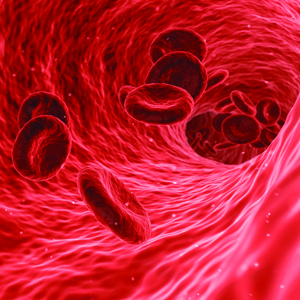Sex Hormone Binding Globulin
 Steroid hormones, including testosterone, estrogens, DHEA, and progesterone, among others, are fat-soluble, but our blood is mostly water. Therefore, although hormone levels in the blood must be just right for optimal health, hormones and blood do not mix very well. The body’s solution to this problem is sex hormone-binding globulin (SHBG), a protein created by the liver which connects with the fat-loving hormones.
Steroid hormones, including testosterone, estrogens, DHEA, and progesterone, among others, are fat-soluble, but our blood is mostly water. Therefore, although hormone levels in the blood must be just right for optimal health, hormones and blood do not mix very well. The body’s solution to this problem is sex hormone-binding globulin (SHBG), a protein created by the liver which connects with the fat-loving hormones.
The resulting complex becomes water-soluble and can move freely in the bloodstream, carrying these hormones throughout the body. It also acts as a reservoir for the hormones it carries and protects the hormones from hyperactive liver metabolism and kidney excretion.
The Relationship with Hormones
Hormones combine with SHBG to different degrees of affinity or attraction. The most strongly bound hormone is dihydrotestosterone (DHT), the active form of testosterone, followed by testosterone itself.
Although to a considerably less degree than DHT and testosterone, SHBG also shows an affinity for estrogens, DHEA, and even progesterone. Estrogens increase SHBG production in the liver if the liver is functioning correctly. Adiponectin, a hormone released by the fat cells, is also involved.
Hormones related to testosterone decrease SHBG production by the liver. Insulin, hypothyroidism, and liver disease may also decrease SHBG. Low levels of SHBG may be predictive of:
- Metabolic syndrome
- Diabetes
- Sleep apnea
- Polycystic ovary syndrome (PCOS)
- Kidney disease
- Obesity
Testing SHBG Levels
A useful test for checking hormone levels involves collecting urine for 24 hours and measuring the amount of hormone leaving the body that day. If a patient has low SHBG levels, testosterone will come out in the urine in greater amounts and may be interpreted as the patient having plenty of testosterone when their level is actually low. In order to accurately interpret the urine test results, the urine test should be accompanied by a blood test.
An interesting scenario happens when testosterone is used as a supplement. As mentioned previously, testosterone decreases SHBG production by the liver. With less SHBG available over time, the supplemental doses of testosterone are more rapidly excreted by the body and don’t have an opportunity to build up in the blood and get to the tissues. It is important to test for SHBG especially if testosterone supplementation does not appear to be working.
Imbalance-Associated Health Problems
Low SHBG causing low testosterone availability puts one at risk for sleep apnea. Poor sleep can, in turn, cause a decrease in testosterone, SHBG, and growth hormone production, creating a vicious circle. Regaining weight after weight loss can be predicted by low SHBG is also characterized by low SHBG.
If SHBG levels are too high, both testosterone and estrogens are bound. High levels of SHBG increase one’s risk for osteoporosis because the testosterone and estrogens needed to assist with bone formation are not available for use. Birth control pills can increase SHBG greatly, and high SHBG can be predictive of blood clot formation while on these drugs. High SHBG can also be predictive of cardiovascular disease.
Conclusion
Understanding SHBG is another tool to use in evaluating hormones. We are often tempted to label functions in our bodies as “good” or “bad” and some might apply this thinking to SHBG levels. There isn’t good or bad SHBG, just the levels that provide the best functioning for our bodies.




